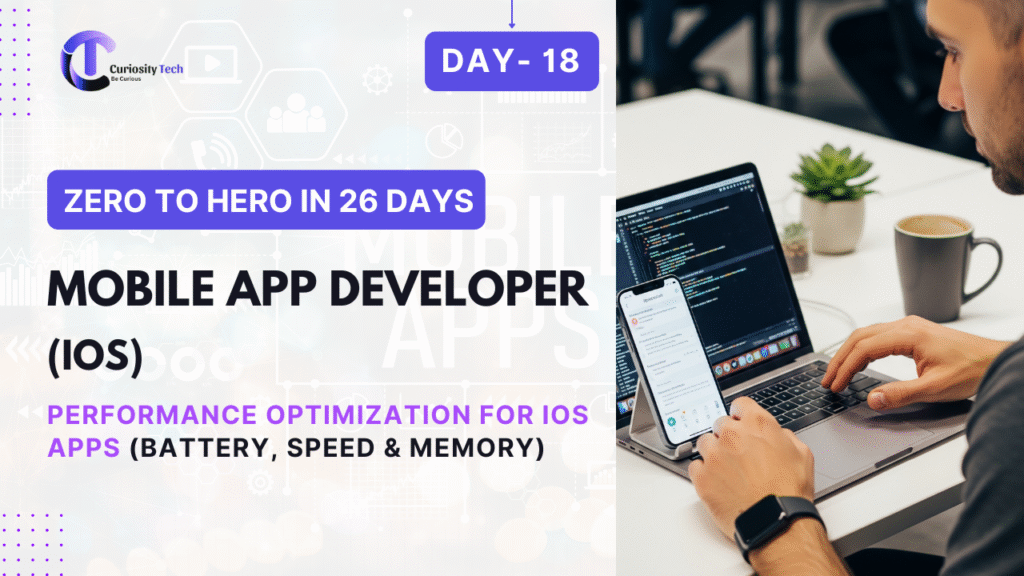iOS development in 2025 is at an inflection point. Apple’s ecosystem has expanded beyond iPhones to include Vision Pro (spatial computing), Apple Silicon Macs, Apple Watch, and HomeKit devices. The role of an iOS developer has grown: it’s no longer just about building apps, but about creating seamless experiences across Apple platforms.
At CuriosityTech.in, we prepare developers to stay ahead by mastering cutting-edge trends: SwiftUI dominance, AR/VR with ARKit & RealityKit, AI-powered apps, SwiftData for persistence, and cross-device integration. Let’s explore them in extreme detail.
1) SwiftUI as the Default UI Framework
- Trend: UIKit is still supported, but SwiftUI is now Apple’s primary UI framework.
- Why: Declarative syntax, cross-platform compatibility, faster prototyping.
- Mandatory Features in 2025:
- Advanced animations with .phaseAnimator.
- Multi-window support (iPadOS, macOS, Vision Pro).
- Swift Charts integration for analytics.
- Seamless data binding with Observable, @State, and SwiftData.
- Advanced animations with .phaseAnimator.
Best Practice: New apps should be 100% SwiftUI-first, and UIKit only used for legacy modules.
2) SwiftData (Next-gen Core Data)
- Introduced in iOS 17, SwiftData replaces Core Data as the modern persistence layer.
- Fully integrated with SwiftUI → automatic UI refresh when data changes.
Example:
@Model
class Workout {
var name: String
var duration: Int
init(name: String, duration: Int) {
self.name = name
self.duration = duration
}
}
- Works seamlessly with @Query in SwiftUI views.
- No boilerplate context management.
Mandatory Skill in 2025: Every iOS dev must master SwiftData + SwiftUI integration.
3) ARKit 6 & RealityKit for Spatial Computing
- With Vision Pro, Apple doubled down on AR and VR.
- ARKit 6 + RealityKit allow developers to:
- Build immersive AR/VR experiences.
- Use Scene Reconstruction for real-world mapping.
- Integrate with USDZ models for 3D assets.
- Build shared AR experiences with Multipeer Connectivity.
- Build immersive AR/VR experiences.
Example Use Cases:
- Fitness apps with AR workout overlays.
- E-commerce apps with AR try-on.
- Education apps with 3D models in ARKit.
Mandatory in 2025: Every serious iOS dev should understand ARKit + RealityKit basics, even if not specializing in AR.
4) AI & Core ML Integration
- Trend: AI-driven apps are mainstream in 2025.
- Apple’s Core ML 6 supports:
- On-device LLMs for privacy-first AI.
- Image recognition, natural language processing.
- Integration with CreateML for custom datasets.
- On-device LLMs for privacy-first AI.
- SiriKit + App Intents → allow apps to integrate with Apple’s ecosystem and leverage natural language commands.
Example Use Cases:
- Fitness apps predicting workout routines with ML.
- Finance apps detecting fraud patterns.
- Education apps providing AI tutors offline.
Mandatory for 2025 developers: Learn Core ML + on-device AI optimization.
5) Async/Await & Concurrency Everywhere
- Concurrency with async/await, structured concurrency, and actors is now standard.
- Combine is secondary; Swift Concurrency is mandatory.
- Networking, Core Data/SwiftData, HealthKit, and CloudKit all adopt async APIs.
6) Security & Privacy as First-class Citizens
- With GDPR updates and Apple’s stricter App Store privacy rules, apps must:
- Use App Tracking Transparency (ATT).
- Provide Privacy Nutrition Labels.
- Implement Keychain for sensitive data.
- Use Secure Enclave for biometrics.
- Use App Tracking Transparency (ATT).
Mandatory in 2025: No app can pass review without explicit privacy compliance.
7) Cross-Platform Development (Apple Ecosystem First)
- iOS devs are expected to build apps for:
- iPhone & iPad.
- Vision Pro (visionOS).
- Apple Watch (watchOS).
- macOS (Mac Catalyst + SwiftUI).
- iPhone & iPad.
Unified SwiftUI codebase makes this feasible.
Trend: Many companies now hire iOS developers as Apple ecosystem developers, not just iPhone app devs.
8) New Developer Tools
- Xcode 17+: AI-powered code completion, real-time SwiftUI previews, concurrency debugging.
- Swift Testing: New modern testing framework (replacing XCTest gradually).
- Instruments: Expanded to profile energy, memory leaks, and concurrency issues more deeply.
9) App Store Trends
- Smaller Apps with On-Demand Resources (modular downloads).
- Subscriptions + HealthKit/AI features are dominant monetization models.
- TestFlight Beta Testing mandatory for early validation.
- Vision Pro App Store → huge new market for developers.
10) Developer Career Impact
| Trend | Skill Required | Career Impact |
| SwiftUI | Mastery of declarative UI | Mandatory for jobs |
| SwiftData | Modern persistence | Core skill |
| ARKit/RealityKit | AR/VR basics | Differentiator in CV |
| Core ML | AI integration | Competitive edge |
| Concurrency | async/await mastery | Mandatory |
| Security | Keychain, ATT, Secure Enclave | Non-negotiable |
| Cross-platform | visionOS, watchOS | Expands career scope |
Example: Fitness App in 2025
A fitness app built at CuriosityTech.in in 2025 uses:
- SwiftUI for UI.
- SwiftData for local workout storage.
- Core ML to suggest personalized workout plans.
- ARKit to overlay posture guidance in Vision Pro.
- Async/await for smooth HealthKit + API sync.
- App Intents for Siri shortcuts: “Hey Siri, log my workout.”
This future-ready app shows how trends combine to create next-gen user experiences.
Conclusion
In 2025, iOS development is no longer just about iPhones — it’s about the entire Apple ecosystem. To remain relevant, developers must master SwiftUI, SwiftData, concurrency, ARKit, Core ML, and cross-platform design. Security and privacy are not optional but mandatory. Those who adapt will thrive in high-demand roles, while those who cling to old UIKit-only patterns will struggle.
At CuriosityTech.in, we train learners to anticipate these changes, ensuring they build apps that are future-ready, App Store-compliant, and user-loved.



